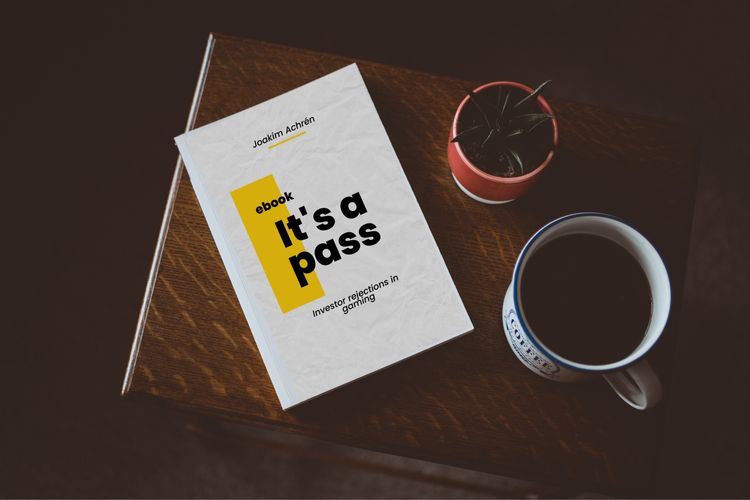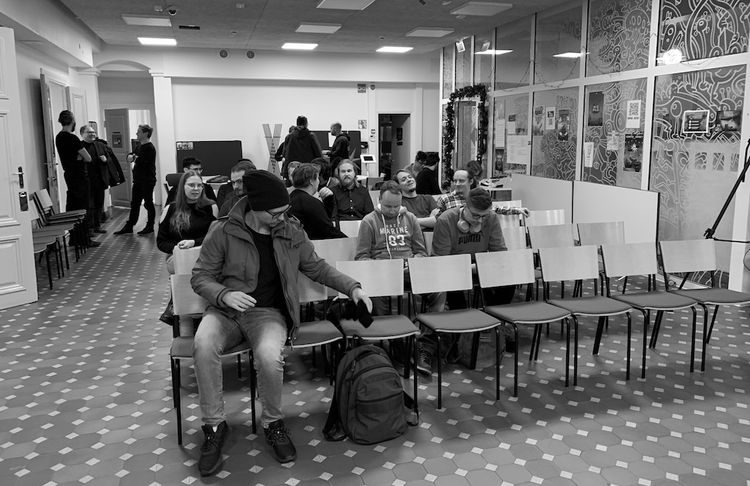EGD News #58 — Investor feedback on the game


Sent on December 4th 2020.
If you aren’t a subscriber to EGD News, you can subscribe here.
Hi there,
It’s Joakim here. Greetings from Helsinki!
We are a few days away from the launch of the Gaming Angel Fellowship. I’ve had a group of people review the course. Based on the feedback, I’ve added new content to the course, emphasizing my personal thoughts on investing.
Here’s some of the new editions to the course material:
Evaluation: How do I evaluate gaming studios, versus tool or service startups for gaming.
Dealflow: I approach talking to startups as a funnel, where I have calls with a portion of the companies and investing in a small fraction.
Pitch decks: What I look for in pitch decks, what questions I ask after seeing a pitch deck.
Founders: Talking to the founders of a games company, what questions do I ask?
Valuation: How would I go about determining a valuation for a company that’s looking to raise an angel round?
Results: I’ll give an example on one of the companies I’ve been working with, and how they’ve achieved success after their angel round.
To follow the launch news on Gaming Angel Fellowship, do sign up on the site.
Let’s now cover this week’s news.
🎮 Investor giving feedback on the game
One gaming investor superpower comes from being able to give feedback on a build. Here I try to give some focus areas where anyone could develop their feedback giving skills.
The idea for this came from a recent LinkedIn post by Gamejam CEO Christian Calderon, where Chrisitan had posted a feedback slide from his investor Henric Suuronen from Play Ventures. In this slide, Henric shares his personal thoughts on how to improve the game that Gamejam is working on.
This is exceptional work from an investor. As Christian says:
“Last week Play Ventures played our latest game Racing Rhythm and gave us a detailed presentation of feedback and game design improvements. Not many VCs are qualified to give expert game design advice like Henric Suuronen and Harri Manninen—we love you guys!!!!”
I’ve been practicing a format of giving game feedback. I don’t think I can compete on the same level as Henric, but here’s how I break down my feedback when I playtest and then talk with founders about their game.
How I playtest and generating feedback
First, I play the game extensively, for at least two to three hours, during a few days.
The early sessions:
The first time I play the game, I try to write down all the issues that I’m facing with understanding the game. I often get to play builds where the developers haven’t yet included a tutorial and it can be hard to know what buttons to press and which things to interact with.
Jot these down as soon as possible. Once you start understanding the game, it’s hard to remember the interactions that didn’t make sense in the first place. You become blind to the obvious.
I spend the first ten levels, or 30 minutes, playing the game and try to get into a flow of enjoying the game. I start looking for interesting choices that I get to make as a player, looking for things to learn, elements of gameplay that I’d want to master. I write down all that I encounter, good, meh, and bad.
The later sessions:
I try to reach the end of the content so that I get a feel for the entire game as it is. This might take hours on early builds, and days with more developed ones.
In the later game sessions, I’m looking for more enjoyment from flow, progression in my player skills (mastery), and the metagame. What is the depth of my choices? Do I feel that the game is revealing more interesting stuff to come?
Ideas and bugs
Once I feel that I’ve played enough, I put on my “game designer hat” and start thinking about the areas I’d work on. How I might create more excitement for the player, more flow, more interesting choices, metagame depth, and UX improvements.
All the bugs that I’ve encountered will be shared with the developers. I take screenshots and highlight items on the screens.
If you haven’t worked on games before but want to give feedback?
I think that any investor could give feedback on builds. If you don’t think you can communicate game design terminology, just focus on:
A. The moments of confusion, which parts of the game were hard to understand.
B. Flow. Where you didn’t want to stop, since that will tell the developers what is working well and what isn’t.
C. Feeling progress where you learned new skills, new mechanics or discovered interesting choices or options in the game.
📈 Early-Stage Success in Gaming
Last week, I did a webinar with James Cramer from Skunkworks Games, who’ve recently found success in the merge genre of mobile with their game MergeFrinds. I want to revisit all the points that we went through on the webinar.
Early Stage Focus
First, the company set forth to raise at least €30k to trigger €50k grant from Business Finland. After raising a combined €100k, the team focused on two aspects
A. Keep costs as low as possible for as long as possible until something stuck.
B. Use the combined €100k to build and validate as many games as possible, as quickly as possible.
My five cents: rapid development and focusing on games that can be built as quickly as possible, helps to mitigate a lot of risks, like one big game, where below-average metrics could jeopardize the company. Or needing to raise additional funding to pivot to a new game.
“I went back over some old conversations with one of our angels. I told him that we’d make 6-10 prototypes in 2020. We made three, and one worked. So, we were on course, to do something good.”
MergeFriends showing promise, drop everything else
“[MergeFriends started] killing it in soft launch. Doing really well. And it was enough to allow us to make a decision very quickly, Hey, we just drop everything else we’re doing and we just focus on this. Like we drop all the pretense. We just go forward with this.”
Rapid development principle
“So we’re fast when it comes to to prototyping and getting the game out into soft launch. If we were to do this process again, now, I don’t think much would change. One thing that would change is the level of quality in that two months [of development] — the ability to get something even better into soft launch. And I think one month to validate is just about right, because you get your day-30 [retention number.]”
Fundraising is a Dungeon Crawler
I wrote this tweet a while ago:
“Building a startup is like playing a game, with lots of levels and boss fights. Eventually, you beat the boss and get to the next level. But the content gets harder, so you need to get better along the way.” Check out the Tweet here.
James illustrates the example of a dungeon crawler, where the company needs to graduate from one stage to the next, before they can raise from the investors who operate in those stages.
“If you like us: a less experienced team, you’ll need to work your asses off. Just stay in the first dungeon, until you are absolutely sure that you have everything you need to get into the second one. For us, that meant making multiple prototypes.”
“To get through into preseed, that meant having a game with very good metrics. And not just a couple of days of metrics, but an entire 30-day cycle. We needed to be able to project the retention numbers and the engagement numbers. Revenue wasn’t that important, and it’s still not that important now.”
“Just stay in lane until you’re absolutely sure you can pass the next dungeon.”
“Become OP (over powered) in the dungeon you’re in and then move forward.”
Favorite questions from Q&A
Q: “What could speed up the fundraising process in the very early stages?”
A: “Not spending time with VCs. More angels. Be more open for smaller tickets. You should create some competition. You have to get investors to move a bit faster. Create FOMO (fear of missing out), make them think they’re going to miss out, unless they get involved right now.”
Q: “Did you look at different KPIs than normal KPIs?”
A: “We could see that in our first game, people were playing like 30 to 50 sessions. Then with MergeFriends, we were seeing 150 to 200 sessions or even 300 sessions. We tend to look at is the percentiles: How much does the Top 10% play? How many sessions in a 28-day period? So yeah, we’re looking at the session data.”
Q: “How do you see the value between publishing independently on your own, or via a publisher, for a small team?”
A: “Consider this: Would you allow a 3rd party to write a whole base of code for you, that makes your game successful? Or would you rather try to learn that in-house? Would you rather try to figure that out with your existing team? I don’t think it should be any different with UA. If you want to know as a team, how to build and grow a game, if you’re a free-to-play mobile game studio, your business is the first thing you should learn.”
Listen to the discussion via the podcast, or watch the video recording here.
📃 Priced Rounds for Gaming Startups
I’ve previously talked about convertible notes, which are a form of investment, where the investor loans money to the startup, in exchange for terms that allow the investor to convert their loan into equity in the company.
Eventually, the company will want to do a priced round, where the actual investment is converted into shares, also known as equity, in the company. The priced round usually happens when institutional investors, especially VCs (venture capitalists) get involved.
Read the article on priced rounds and check out the templates here.
📃 Articles Worth Reading
+ Joining Mobile’s Most Exclusive Members Club — “Metagame wise, an increasing amount of mobile games featuring similar levels of depth is a clear and recent trend. Mr. Autofire, arguably the most successful game (after Archero) that is truly following this HybridCasual playbook, has earned approximately 5% of Archero’s revenue over the past 6 months.”
+ Five Lessons From Dave Chappelle — “The first lesson from Dave Chappelle’s latest release on Instagram, Unforgiven, is that one best not compete with Chappelle when it comes to storytelling; the way in which the comedian weaves together multiple stories from his childhood on up to the present to make his argument about why he should be paid for the rights to stream The Chappelle Show is truly extraordinary.”
+ Learnings from a decade of company building — “Having a company culture where killing projects is considered normal is crucial in mobile games. You also have to consider the fact that a successful mobile game never really dies, but rather that you will keep developing this evergreen game continuously. The question becomes how to balance how many people should service the older, proven games against how many people should spend their time trying to come up with the next big thing.”
💬 Quote that I’ve been thinking about
“I believe that getting the culture right is the most important thing a company can do.” — Tony Hsieh
Sponsored by ironSource
We all know that developing a great game is one thing, but developing a great game business can be something else entirely. That’s why some of the top game developers in the industry use ironSource’s game growth platform, which takes care of both sides of the business, helping you monetize to fuel user acquisition, and vice versa.
From their ROAS Optimizer, the only product on the market built to optimize UA campaigns towards ROAS according to both IAP and ad revenue data, to LevelPlay, their in-app bidding solution, they offer everything you need to supercharge your growth. See for yourself at ironsrc.com
Sponsored by Opera Event
Looking for some great new authentic video creative? Try something totally new with Influencer Generated Content (IGC) by Opera Event. Influencers or actors will make specific creative content for your games and Opera Event will deliver you high-quality video ads that highlight the best parts of your game.
Note! You get a free video with the purchase of 4 or more videos. Remember to say that Elite Game Developers sent you!
Go to www.getigc.com to see some examples and get more information.
That’s all for this week. Take care and stay safe!
Joakim
Did you enjoy this article?
Here’s some more related ones.





